|
|
7.9 out of 10 based on 14 ratings

By Jo Nova
The government has this hope that homeowners can be tricked into paying for the batteries (in the form of EVs) that the wind and solar industry need to make their useless random energy into something reliable. Now comes the news that not only are batteries hazardous fire risks and expensive themselves, but to connect to our grid in a two way arrangement we need to spend $3,000 dollars per household (or maybe $10,000) to buy the bit of equipment that makes this work. Not to mention adding another million gigawatts of generation so the cars can be charged in the first place.
Remember in the end, we are not buying EV’s because they go further, cost less, or are more convenient, we’re buying them because we want to stop storms in 100 years.
How many nice weather days will I get in 2100AD for that $3,000 inverter?
By Natasha Schmidt, The Australian
Interim Director of Monash Energy Institute, Roger Dargaville, said powering EVs in just one million households could cost as much as $10bn in power inverters.
Professor Dargaville said such inverters, unlike home batteries such as Tesla’s Powerwall, would allow EV drivers to recontribute power into the grid.
“That piece of infrastructure costs about $10,000 at the moment, and if you have a million vehicles sometime in the future trying to do this that’s $10bn,” he said.
Prof Dargaville hopes that mass production might reduce the cost to $3,000 each if we are lucky. (Mass money printing and inflation will probably prevent that.)
Historians will look back on this era and describe it as a case study in corruption and mass delusion. The great capitalist free market of Adam Smith exists only in limited pockets that masquerade as “free choice”.
10 out of 10 based on 75 ratings
8.4 out of 10 based on 28 ratings
By Jo Nova
If Australia gets any more free cheap energy we’ll go broke
The Australian Energy Regulator has the data on electricity pricing and possibly a budget $20 million a year but hasn’t yet updated with the last quarter, so I thought I’d help them out. Because surely this is a graph that all Australians need to see?
This is every state in the National Energy Market, and even though some have more renewables than others, the long term trends are the same. Unreliable generators in one state can vandalize the whole market:
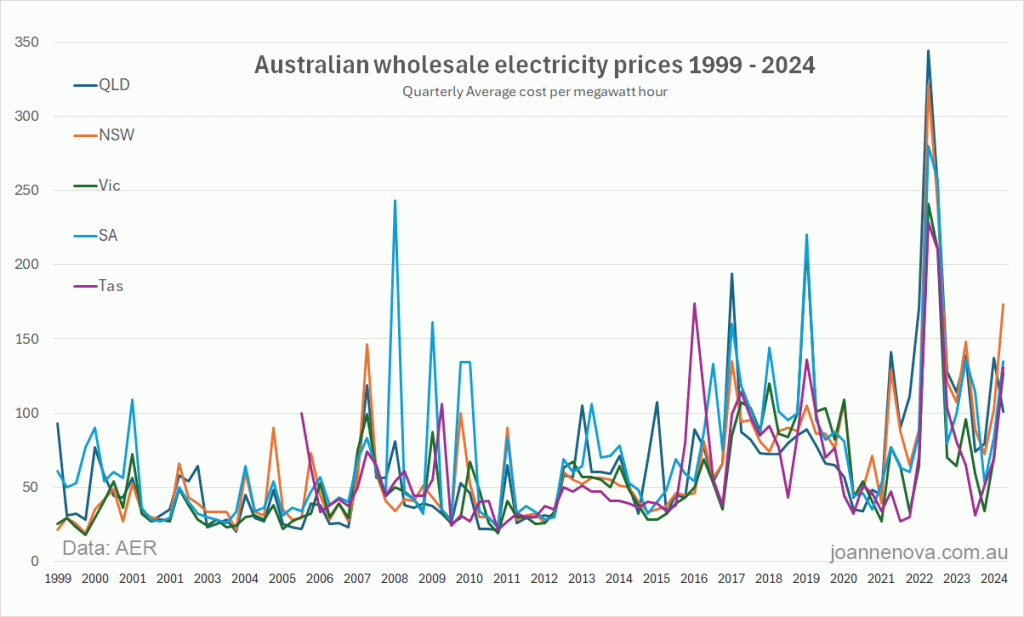 (Click to expand). Back in the dinosaur days when Australia had virtually no wind and solar power, the price for wholesale electricity was $30 a megawatt hour year after year. Then Kevin Rudd was elected in 2007, and we started to add the intermittent, unreliable generators which have free fuel, but need thousands of kilometers of wires, batteries, subsidies, schemes, farmland, FCAS markets, and an entire duplicated back up grid that sits around not-earning money for hours, days or five years at a time.
And we wondered why electricity got more expensive:
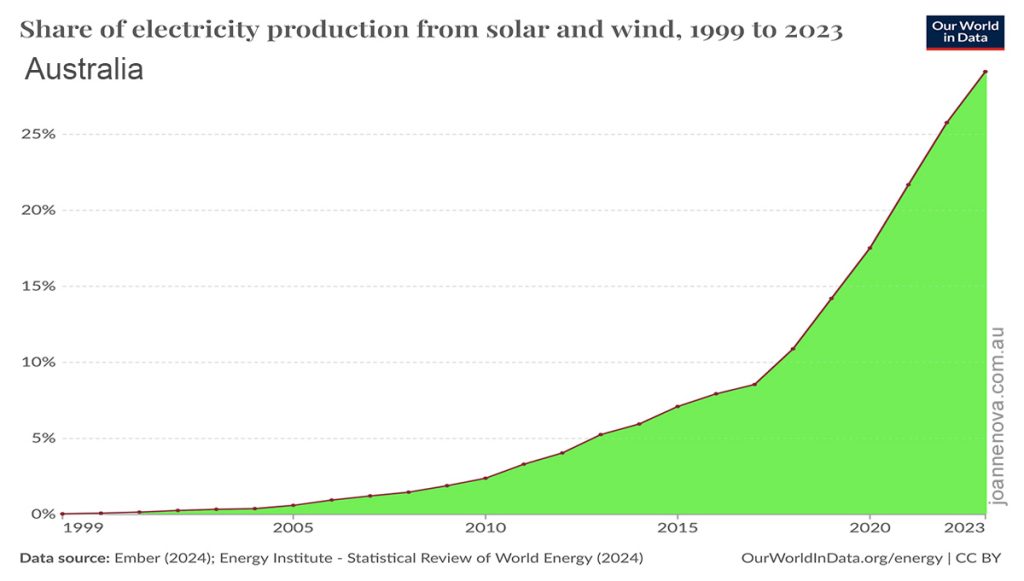
And again with labels.
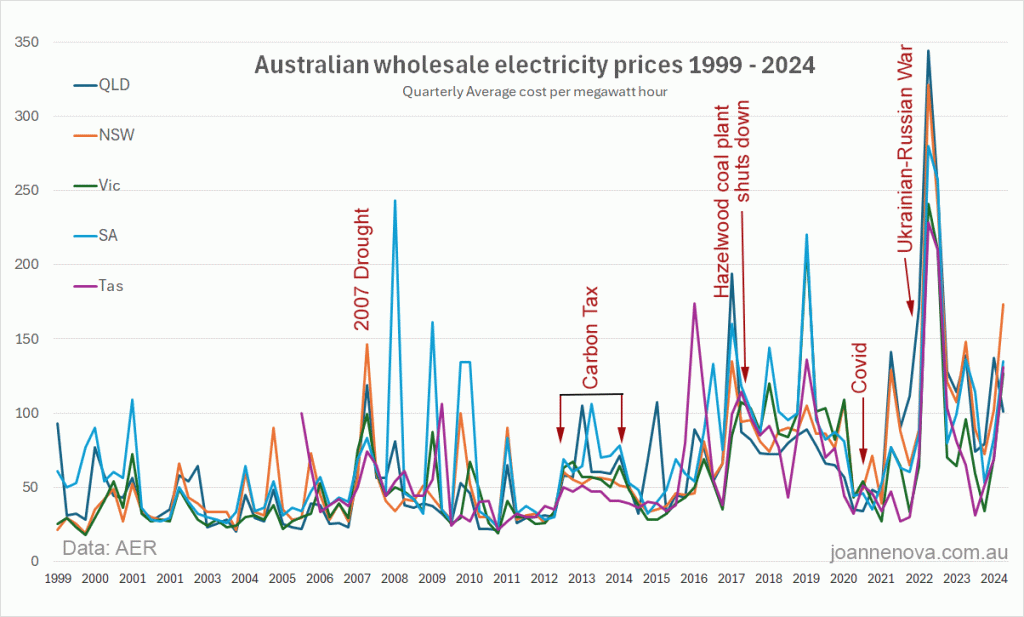
The market never did recover from the closure of the Hazelwood coal plant. Costs rose by 85% and it took a pandemic to bring them down again, but only temporarily.
So Australia is close to 30% total wind and solar generation, and aiming with gossamer fairy wings for 82% in five years time.
Luckily, it appears there’s no chance we’ll get there. The solar daytime glut, negative prices and community hatred of high voltage lines is spoiling the market for developers. And not a day too soon….
REFERENCES
Keep reading →
9.8 out of 10 based on 97 ratings
8.4 out of 10 based on 14 ratings
By Jo Nova
It’s another outbreak of the Hottest-ever-Day Fever , where buses catch fire, and the worlds top journalists forget to ask anyone anything useful about the last 500 million years.
The Copernicus data might be fine and dandy but it only goes back as far as 1979. The warm weather we are having now is just a welcome break in a cooling trend that started 7,000 years ago. It not only isn’t a record that means anything, it’s almost certainly a net benefit to warm blooded mammals.
The collective amnesia about the Holocene and most of the history of human civilization is complete. Apparently the world is in uncharted territory, except for thousands of rocks, stones, spears, shells, bits of wood, pollen, diatoms, fossilized plant leaves, and all the ice cores we’ve ever dug up. 4,000 stone-age spears and whatnot that melted out of the Norwegian glaciers in the last few years, must have frozen into them sometime in the last 5,000 years. And all the bones of dogs, rabbits, geese and frogs found inside the Arctic circle suggest our world is too brutally cold now. Likewise the giant oyster shell found on a building site in Taiwan reminds us of a time the oceans were 1 to 2 meters higher than today, and the cavemen survived just fine.
CNN By Angela Fritz
Sunday was the hottest day in recorded history, according to preliminary data from a climate tracking agency monitoring temperatures since the mid-1900s.
It’s the second consecutive year average global temperatures have crashed through shocking climate records and will not be the last, as planet-warming fossil fuel pollution drives temperatures to shocking new highs.
July 21 clocked in at 17.09 degrees Celsius, or 62.76 Fahrenheit, and was the hottest day on Earth since at least 1940, according to the preliminary data from the European Union’s Copernicus Climate Change Service.
It’s 100,000 years of journalistic negligence:
Despite being based on data from the mid-20th century, the temperature records represent the warmest period the planet has seen in at least 100,000 years, scientists have found from many millennia of climate data extracted from ice cores and coral reefs.
Someone should send Angela Fritz (and most of the world’s journalists) the graphs of the ice cores which she has clearly never seen:
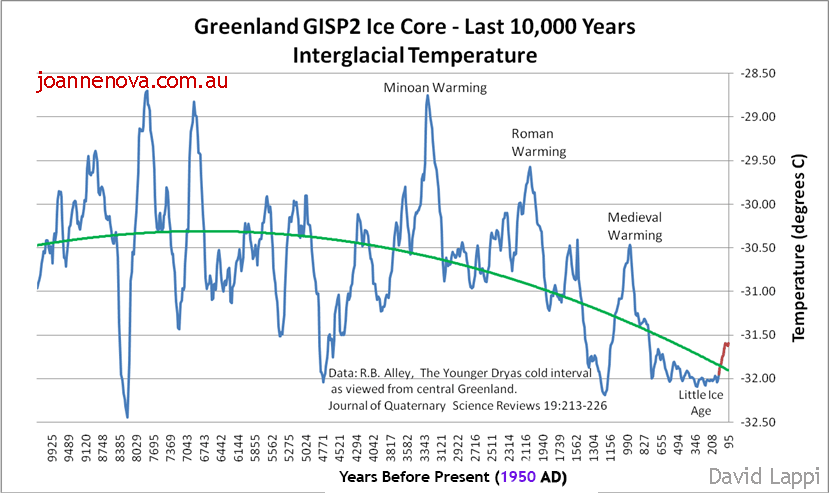 7,000 years of cooling in Greenland. This graph shows the ice-core data up until 1855. The last 150 years (1705 to 1855) are highlighted in red to show the warming as the Earth began coming out of the LIA. Send them the Vostok Ice Cores too. Send them Brazilian sea levels, and tell them the the Sahara was lush green and wet, and the water near Indonesia was 2 degrees hotter. And 6,000 boreholes drilled around the world agree, along with 700 Pacific Islands that aren’t shrinking. The real science deniers are the ones ignoring half a billion years of evidence.
It’s been hotter for thousands of years during human civilization and it wasn’t caused by our cars.
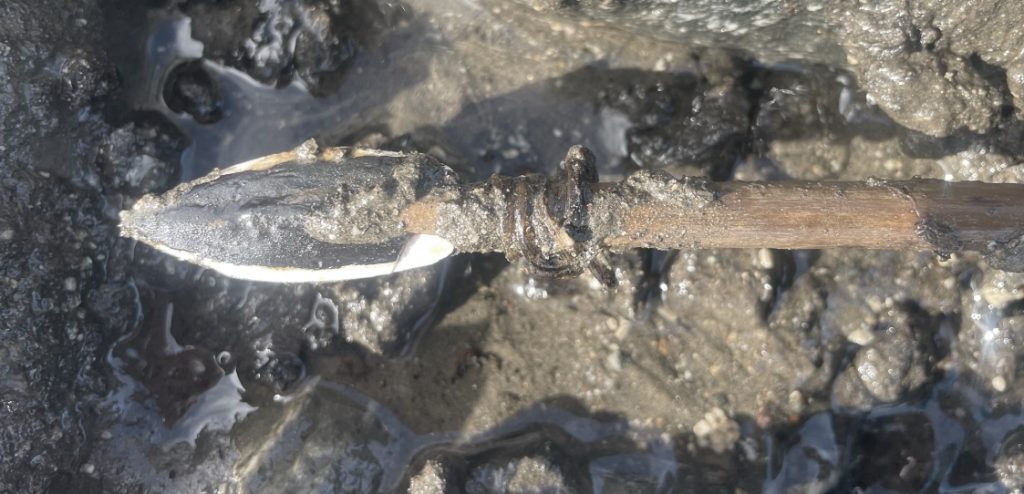 https://secretsoftheice.com/ REFERENCES
Copernicus media release –they it’s a the hottest day “in recent history” which the media turned into the hottest day in a hundred thousand years. h/t Gee Aye
Keep reading →
9.8 out of 10 based on 99 ratings
8.7 out of 10 based on 15 ratings
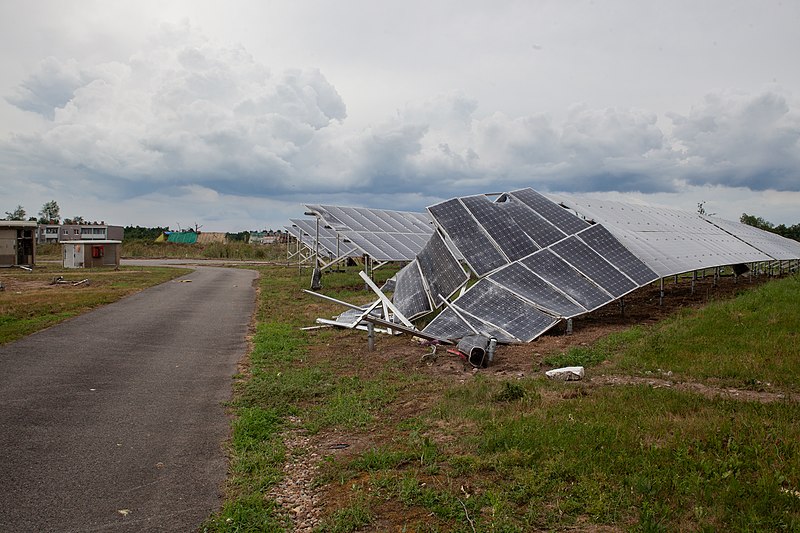
By Jo Nova
Europe’s solar manufacturers are in a crisis
Forty year old German solar panel producers are closing factories they only opened three years ago.
The world now has the capacity to make 1,600 GW of solar panels annually, but demand has unexpectedly flat-lined — staying at barely 500GW. In a world awash with solar panels that no one needs, prices have fallen dramatically, but that hasn’t solved the glut which is so bad, people are using solar panels for fencing in Europe.
The CCP has bet big that the exponential growth curve in solar customers was going to keep being exponential. Instead, demand flattened off suddenly. Currently, 80% of the world’s solar panels are pouring out of China.
With impeccable timing, just weeks ago the Australian Government threw a billion dollars at a program to help Australia become a solar panel superfactory just at the moment when China is practically giving them away.
Rachel Millard and Amanda Chu, Financial Times
“There is overcapacity in every segment, starting with polysilicon and finishing with the module,” said Yana Hryshko, head of global solar supply chain research at the consultancy Wood Mackenzie.
According to BloombergNEF, panel prices have plunged more than 60 percent since July 2022. The scale of the damage inflicted has sparked calls for Brussels to protect European companies from what the industry says are state-subsidized Chinese products.
Europe’s solar panel manufacturing capacity has collapsed by about half to 3 gigawatts since November as companies have failed, mothballed facilities, or shifted production abroad, the European Solar Manufacturing Council estimates.
The Salad Days of Solar Power are behind us
The sudden death of the solar boom is due to rising interest rates which take the fun out of getting a loan, but it’s also due to rising electricity costs, which increase the prices of everything, including solar panels themselves and the batteries they need to back them up.
But there’s an argument to be made that the grid itself has reached the limit. The Duck Curve has been quacking on grids in California and Australia for years. Ponder that in towns like Alice Springs the microgrid is in danger of falling over when a cloud rolls in, and only 1 in 4 homes there have solar panels. Indeed, in the sunny centre of Australia, the limit for solar power appears to be just 13% — meaning it’s hard to stabilize the grid when more than 13% of the annual supply is made from solar power.
When storms knocked over a high voltage line in South Australia the first thing the government did was to ask people to switch off their solar panels so they wouldn’t crash the grid.
Even on the big grids, there’s already such a glut of solar panels on homes, that the midday surge of “green” electrons is causing voltage surges which can damage other equipment. Solar “feed in” tariffs to homeowners are shrinking to nothing, or even going negative themselves. In Adelaide and Perth the government now insists people installing solar panels get smart meters so the grid managers can remotely switch off their panels. Worse, in Sydney solar home owners now have to pay to dump unwanted solar power on the grid at lunchtime.
Then there’s the mayhem of negative prices on national markets which is driving baseload providers off the grid and out of business. Large industrial generators are restructuring their businesses to accommodate the crazy pricing.
Last word: China already controls 80% of the market, would it really want to dump so many solar panels it drove the last 20% out of business, or was this just one huge Big-Government mistake?
Photo: Tadeáš Bednarz
9.9 out of 10 based on 111 ratings
7.7 out of 10 based on 14 ratings
7.9 out of 10 based on 34 ratings
7.8 out of 10 based on 22 ratings
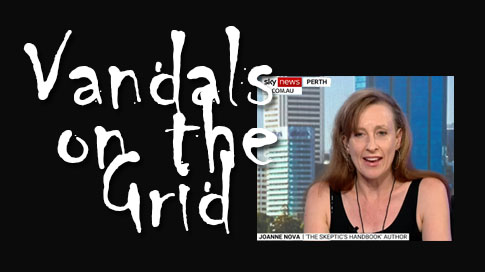 If you are in Perth this weekend, I’ll be speaking about vandals and witchcraft in the National Energy Market for the Council for the National Interest (CNI) If you are in Perth this weekend, I’ll be speaking about vandals and witchcraft in the National Energy Market for the Council for the National Interest (CNI)
Sunday 21st July 2024, 2.30pm to 4.30pm (Socialising from 1.30pm to 6.00pm) at the APIWA Clubroom, Rear No.10 Mallard Way Cannington 6107.
Readers here are welcome tomorrow. There is no charge but please RSVP to apimail AT apiwa.com.au
9.9 out of 10 based on 54 ratings
By Jo Nova
Brown coal is the best kept secret in Australia
Imagine, in this cost-of-living crisis, if the nation discovered a 430 billion ton deposit that could produce electricity at a tenth the cost of gas and hydroelectricity? What a bonanza — the people could live like kings with heated pools, large homes, indoor spas and businesses would flock to the state to set up production lines. The state would become a trade giant and a mecca for tech.
Then imagine they let themselves be spooked into not using it for fear it would cause bad storms in a hundred years? Like the country is run by teenage girls…

Source: AER
Despite the costs of everything rising in 2024, the brown coal plants in Victoria are still offering to supply wholesale electricity at $8 per megawatt hour (which is 0.8c per kilowatt hour). That’s the average winning bid from brown coal plants across Quarter 1, 2024.
In the chart below of the last five years of quarterly prices, we can see that every single quarter brown coal power is the cheapest source of electricity there is bar none. (Wind and solar power, with their crazy negative prices, don’t count because they’re subsidized up-the-kazoo. Their real cost is paid through other hidden means. It’s either that, or the negative prices tell us wind and solar power are so awful you have pay people to take those toxic electrons away…).

In the last quarter brown coal set the winning bid price about 15% of the time. These were the times when there was enough brown coal power in Victoria that the grid managers didn’t have to buy any black coal, gas or hydro power at all.
The more coal power Victoria has, the more often the wholesale price will be insanely low…
Because of the way the auction works, the highest successful bidder sets the price for everyone. In theory, generators are supposed to bid the lowest price they’d accept and then the AEMO takes the cheapest offers first until it meets the full demand.
And it’s the same all across the Eastern Coast of Australia — in New South Wales was getting bids from brown coal generators at $12 per megawatt hour. In South Australia, $11. In Queensland $13, and in Tasmania $7.
9.8 out of 10 based on 90 ratings
8.8 out of 10 based on 15 ratings

By Jo Nova
The irony! The only generator that can make affordable hydrogen is brown coal
The Great Green Hydrogen dream was killed by the dual impossibility paradox, it has no customers prepared to pay the Gucci level rates, and it can’t be made cheaper without using brown coal to which would mean it isn’t “green”.
The irony is practically radioactive — analysts admit Green Hydrogen is only economic if a company can get electricity at $30 to $40 per megawatt hour, which Australia had for decades, but blew away by adding “renewables”. Like every other nation on Earth, the more unreliable wind and solar we added, the more expensive our electricity got. These days the only generator that still make electricity at that price now is old brown coal.
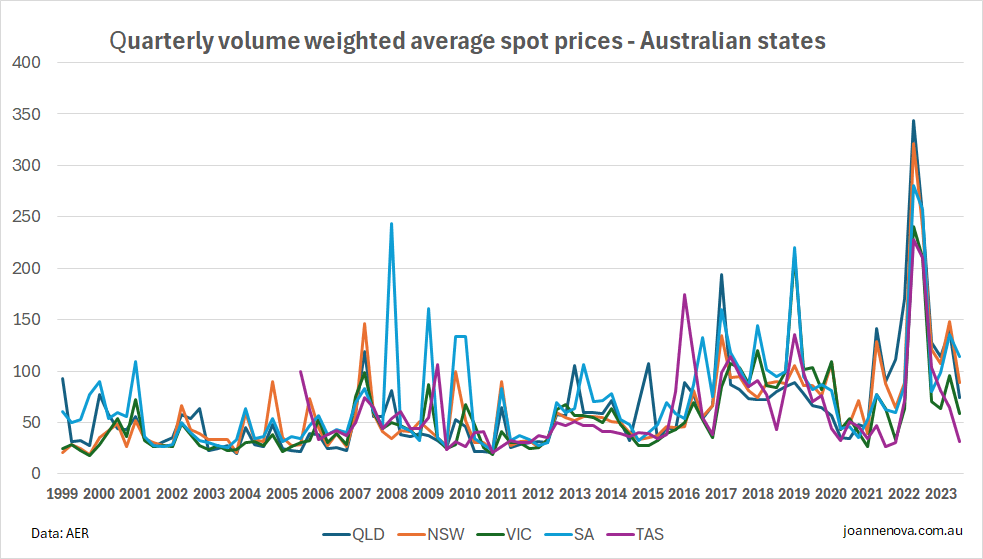
For years Australian average wholesale electricity prices were $30/MWh
Sure, for five minute bids, and with generous subsidies stolen from taxpayers, wind and solar can pretend to be cheaper, but it turns out that the hydrogen factories, like every other factory, aren’t efficient if they stop and start every time a cloud rolls over, or the wind ebbs. All the infrastructure and staff, and the insurance and loans are still sitting around clocking up the bills, while nothing gets done. And all the inflows and outflows need to be adjusted, and the temperatures held steady. It would have been obvious to any precocious ten year old that hydrogen plants needed reliable electricity, which means they needed galactic size batteries to fill in the gaps, and therefore an interstellar budget.
The truth is, no one really wants “Green” hydrogen, or green steel, except as a fashion accessory to brag about at Davos. But people might buy it if it was cheap, which it isn’t. The only way to make it cheaper is with brown coal, which means it’s isn’t green hydrogen, and so we find the nation has accidentally stepped into a Escher Puzzle where all staircases lead upwards and left and end right where they started except the bank balance goes phht with every cycle.
Let’s not underestimate the scale of this debacle
Andrew “Twiggy” Forrest burned off $2 billion dollars (AU) on setting up his Green Dream Hydrogen energy plan which has just collapsed with the loss of 700 jobs. But bigger than that, the Australia Labor Government made it the centerpiece of its $2 billion Hydrogen Headstart program.
For more than two years, Fortescue has been full throttle trying to turn Forrest’s promise of converting green hydrogen into a commercial reality within years.
Instead, as the economics around surging electricity costs needed to produce green hydrogen sunk in, deadlines were pushed back and back. The mission changed, then there was a revolving door of executives.
Twiggy blames fossil fuels and the Russians:
“I am not giving up on hydrogen at all,” Forrest tells The Australian.
“The green electricity price just kept keeps heading north, and It’s been dragged up by the fossil fuel price. We’re not pivoting away. We’re going upstream to get the green electrons at the right price”.
On the 7:30 Report he kept dodging the question of what this meant for Labors big Renewable Nation plan, which means it obvious isn’t good.
At one point he mentioned “the war”. As if somehow a war which limited gas supplies and drove up the price of coal “dragged up the price” of renewables. The truth was that the Ukrainian-Russian War and the death of the Nordstream Gas pipeline should have been the best thing that could happen to renewables. It was their golden market opportunity to fill the gap, but it only exposed how useless they are. When push came to shove, everyone wanted coal and gas, including the companies that make wind turbines and solar panels. The reason wind and solar went up in price was because wind power can’t make wind turbines, and solar power can’t make solar panels, and no one can afford to make batteries.
Those killer costings on Hydrogen:
Matthew Rennie, a former EY partner who is now an independent adviser, said his firm’s analysis indicated that prices for power and electrolysers – which use renewable power to split water into hydrogen and oxygen – would need to be much cheaper to produce green hydrogen in Australia even at under $3 a kilogram.
He said power prices would need to be less than $40 a megawatt-hour and electrolyser costs would need to more than halve to produce hydrogen at that level – still 50 per cent more expensive than the government’s $2 target for the gas to be competitive.
Or worse, $30 a megawatt hour:
By Joe Kelly, Nick Evans and Rhiannoin Down, The Australian
Dr Finkel, said green hydrogen could replace coal as a chemical-reducing agent in the production of iron, but acknowledged its viability was “highly dependent” on the costs of renewable electricity.
He said the goal should be to start producing green hydrogen at about $2 a kilogram, “which would require the electricity that is used to make the hydrogen to be less than about $30 per megawatt hour – which is very cheap.”
The current average price on the wholesale national electricity market in the top two renewable states this month is $199 per megawatt hour (SA) and $214 in Tasmania. Even in Qld and NSW the prices are still $100 a megawatt hour more than they used to be.
Twiggy Forrest and Anthony Albanese believed their own fantasy propaganda. Twiggy was still talking tonight of “infinite” energy in Australia from the sun and the wind, showing how little he cares about numbers that matter.
Image by Pete Linforth from Pixabay
Graph: AER data
9.9 out of 10 based on 109 ratings
9.4 out of 10 based on 10 ratings

By Jo Nova
Is there nothing fossil fuels can’t do?
Climate change makes the Earth wobble on its axis. Now, if you shower too long, and enjoy that beefsteak too much, you could affect the tilt Earths axis. Are you feeling guilty yet, or just fed up that modern science is indistinguishable from the prophesies of Neolithic shamen?
By Harry Baker
New studies, which utilized AI to monitor the effects of climate change on Earth’s spin, have shown that our days are getting increasingly longer and that our planet will get more wobbly in the future. These changes could have major implications for humanity’s future.
We’re talking of fractions of a millisecond:
Initially, these changes will be imperceptible to us, but they could have serious knock-on effects, including forcing us to introduce negative leap seconds, interfering with space travel and altering our planet’s inner core, researchers warn.
So it’s probably your air-conditioner in Power Mode, but it could be due to crustal plates shifting:
A day on Earth lasts about 86,400 seconds. But the exact time it takes our planet to complete a single rotation can shift by tiny fractions of milliseconds every year due to a number of factors, such as tectonic plate movements, changes to the inner core’s rotation and gravitational tugging from the moon.
 And it might have something to do with the moon, or the inner molten core of Earth, which might be affected by the sun’s magnetic field. I mean, we really have no idea, but let’s remake our electricity grid just in case we lose a millisecond? And it might have something to do with the moon, or the inner molten core of Earth, which might be affected by the sun’s magnetic field. I mean, we really have no idea, but let’s remake our electricity grid just in case we lose a millisecond?
When we melt the ice at the poles and the seas rise higher over the equator, the Earth spins slower just like the iceskater who spreads out their arms:
Over the past few decades, the rate of ice loss from Earth’s polar regions, particularly Greenland and Antarctica, has been increasing rapidly due to global warming, leading to rising sea levels.
Which is all very well, except Antarctica hasn’t warmed in a thousand years, the coastline hasn’t changed since we first took photos of it, and 600 Pacific Islands are not sinking or shrinking.
All those emissions sped the world up, and now all those emissions are slowing us down?
In 2020 scientists made a startling discovery. They found that, instead of slowing down, the Earth has started to spin faster. It is now spinning faster than at any time in the last 50 years. In fact, the shortest 28 days on record all occurred during 2020. — ScienceFocus
At the Guardian they’re afraid the extra millisecond will disrupt internet traffic, or screw up financial transactions and GPS. It’s be like Y2K all over again, and we all know how catastrophic that was.
Look at the language here, these people so want to believe we are Gods:
Damien Carrington, The Guardian
The phenomenon is a striking demonstration of how humanity’s actions are transforming the Earth, scientists said, rivalling natural processes that have existed for billions of years.
The change in the length of the day is on the scale of milliseconds but this is enough to potentially disrupt internet traffic, financial transactions and GPS navigation, all of which rely on precise timekeeping.
The other thing that’s persisted for billions of years is radical sweeping climate change. Like this (below). Nature has been screwing up our GPS, our financial transactions and our space travel for millions of years and we just didn’t know it.

Wait til you see how solid this research is — like climate modeling but with less data:
I mean, how accurate were the clocks at recording milliseconds in 1901? We didn’t even define what a second was until 1968. and it’s not like we’ve got many measurements of changes in Earths’ core since then either. Ask Jules Verne?
In the new study, published July 15 in the journal PNAS, researchers used an advanced artificial intelligence program that combines real-world data with the laws of physics to predict how the planet’s spin will change over time.

And this is a Nature paper. Yet the whole thing could have been an AI school project from start to finish. An AI awarded an AI a grant, which produced a “paper” which an AI editor thought was worth publishing, and AI journalists turned into nonsense headlines, which an AI audience clapped. And no one anywhere thought to ask whether the researchers knew Antarctica is not melting, and seas are barely rising, and length of day was shrinking only a few years ago.
Big Government is strangling real science.
REFERENCE
Kiani Shahvandi, M., Adhikari, S., Dumberry, M. et al. Contributions of core, mantle and climatological processes to Earth’s polar motion. Nat. Geosci. 17, 705–710 (2024). https://doi.org/10.1038/s41561-024-01478-2
9.9 out of 10 based on 85 ratings
9.2 out of 10 based on 15 ratings
 … By Jo Nova
Shh: The great Power Grid Necromancers are at work
And you thought Blackouts were caused by bad management, but really, it’s “Climate Change”. The poor grid managers now have to cope with floods, fires, heatwaves and a tenth-of-a-degree of warming every decade, you know. It’s not their fault. It’s not the Ministers fault. It’s not the fault of the solar power glut, or the wind drought, or the lack of spinning inertia, the dearth of despatchable power, or the byzantine complexity of managing a grid full of unreliable generators being randomly unreliable. The grid is not more fragile because we built 100,000 kilometers of long delicate high-voltage-interconnectors, swaying in the wind, and made of cheap imported steel because we can’t afford to make proper steel ourselves. No!
It’s your fault the blackouts are coming. You didn’t ride your bike, you didn’t eat tofu and crickets, you didn’t buy enough solar panels and you drove your car to work, you planet-monster. What did you expect?
Climate Change is coming for your electricity grid.
It took four writers, five advisors, several editors and probably buckets of money to write an obsequious article radiating nonsense. It’s like a form of mass hypnosis — training the serfs to blame Exxon, and forgive their inept, traitorous Grid Managers, for their incompetent blackouts.
The answer to every problem on Earth apparently, is to buy more solar panels, install more wind farms and use child slaves in the Congo so the weather will be perfect.
The excuse for every bureaucrat failure is “climate change”:
By Eamon Farhat, Misha Savic, Fiona MacDonald, and Mark Chediak, Bloomberg
The bad news for Martinovic and hundreds of millions of people around the world is that the risk of outages is getting worse. Hotter summers mean spikes in demand for cooling, as high temperatures cause wires to sag and risk sparking forest fires. Upgrades to power infrastructure haven’t kept pace, even as efforts to reduce use of fossil fuels make electricity distribution more crucial.
Millions of households in Houston suffered blackouts in the aftermath of Hurricane Beryl last week, losing air conditioning as sweltering heat followed the storm. Hitting emerging and developed economies, outages from Ecuador to India in recent weeks offer a foretaste of coming disruption.
Unstable networks create instability for businesses, roil politics and threaten lives….
All those unreliable generators are making the grid more unreliable, so hurry, we need even more of them.
Pay us more money, pay everyone lots of money.
Global Power Grids Require Trillions of Investment
Expanding the grid will cost about $24.1 trillion to meet net-zero goals by 2050, outpacing the investment needed in renewable-power capacity, according to BloombergNEF.
“The whole power system was built and designed in one climatic era and now is being asked to work in a different climatic era,” said Michael Webber, a professor of energy at the University of Texas at Austin. “It just means more things can go wrong.”
The Earth is warming at 0.13°C every decade. Plant “hardiness” zones are shifting by, hold your breath, 13 miles per decade. The permafrost line has shifted 80 miles north in Canada. Plants can move, you know, but high-voltage lines can’t. It’s so unfair.
If only expert climate models could have predicted this thirty years ago, so we could build power lines 50 miles north…
Most blackouts occur when big chunks of supply or demand come on or off suddenly. Damage from storms, a burst of renewable generation or spikes in usage can all cause outages where the network isn’t resilient enough.
Climate change affects power distribution in lots of ways. Extreme heat increases demand for cooling, while reducing the efficiency of solar panels, crimping supply. High temperatures can cause lines to sag and transformers to overheat, leading to equipment failing and increasing risks of fires.
So solar panels don’t work as well in hot weather when everyone needs their airconditioners on. I mean, who could have seen that coming, apart from a million material engineers?
It’s so unfair.
10 out of 10 based on 97 ratings
9.8 out of 10 based on 10 ratings
|
JoNova A science presenter, writer, speaker & former TV host; author of The Skeptic's Handbook (over 200,000 copies distributed & available in 15 languages).

Jo appreciates your support to help her keep doing what she does. This blog is funded by donations. Thanks!


 Follow Jo's Tweets
Follow Jo's Tweets To report "lost" comments or defamatory and offensive remarks, email the moderators at: support AT joannenova.com.au
Statistics
The nerds have the numbers on precious metals investments on the ASX
|





























